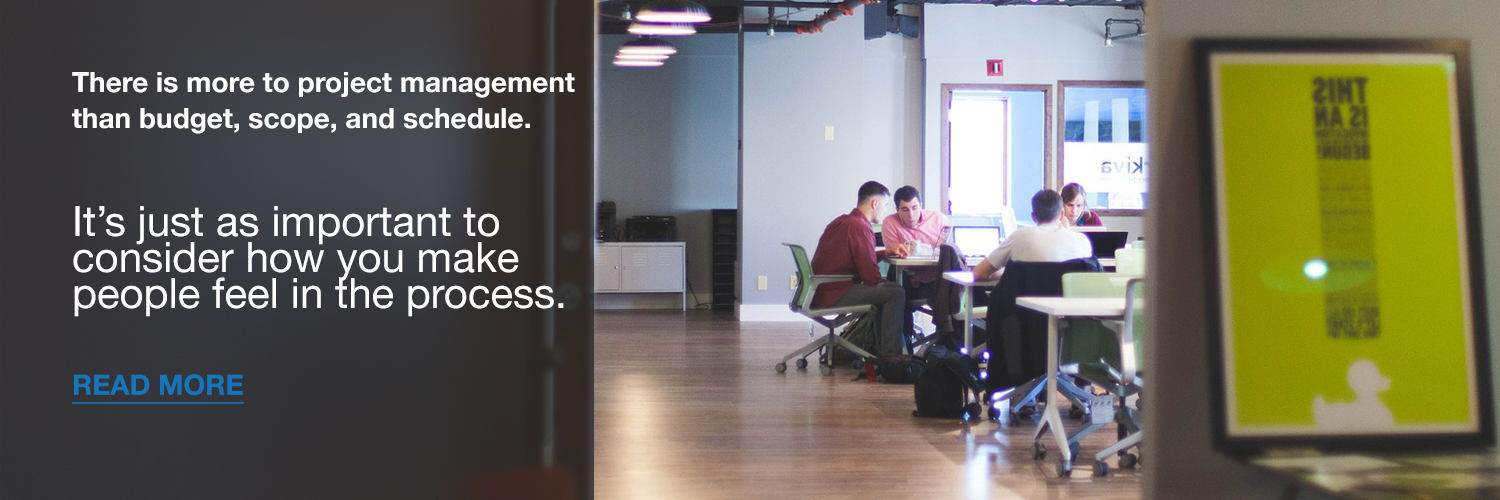We talk a lot about our process — Insight, Clarity, and Enablement — and how that translates into activities and deliverables. But as this process becomes more and more ingrained within our culture, it's obvious that it is bigger than simply a checklist of activities.
Insight, Clarity, and Enablement represents an approach to client engagements that allows our teams (and yours) to move from the highly complex and ambiguous starting point, and into a state of clarity, direction, and ultimately disciplined action.

This thorough and exhaustive process of gaining understanding and insight prior to executing (or even planning) development projects or digital strategies serves to reduce risk — risk of making the wrong decision, risk of going outside project scope, risk of going over budget, or more simply: risk of waste.

What’s more, we’ve found that this process is completely scalable to fit clients of varying sizes and levels of complexity. Paired down or ballooned up, the principle remains the same: insight and understanding drive clarity, and clarity enables positive results.
How We Achieve Insight
Our Insight phase is driven by one thing, and one thing alone:
understanding.
Every activity performed during this stage is done with the intention of gaining a better understanding of you, your market, your audience, and your current condition. With a thorough understanding, we are best equipped to begin making recommendations and taking action.
Questions we often get from prospective or new clients are, “If you’re the expert, why don’t you just know the best strategies and tactics? Why can’t you just tell us what we need to do? Why do you have to perform research just to recommend best practices?”
While completely understandable, the questions are similar to asking “What’s the best car?”
The answer, of course, is “That depends on you, your goals, and your unique situation.”
Sure, we could spend a fraction of the time in the Insight phase, and simply recommend a strategy that mimics that of your competition. But as is often the case, your competitor’s solution may not work for you the way it works for them. What’s more, it may do more harm than good to try and shoehorn “best practice solutions” into your highly complex and unique business environment.
Yes, we do know best practices, and yes, we’ve seen a lot of successful strategies that may work for your company. But when dealing with companies as complex as yours, it is our goal to make the best possible recommendations for you, and build the best possible solutions for you.
And that requires understanding.
Insight Leads To Clarity
Armed with a superhuman level of knowledge about the client’s situation and goals, our team of architects, strategists and engineers can start designing custom solutions for specific problems and requirements, and start defining the most effective approach for the rest of the engagement.
The clarity phase is where ideas and insights become direction.
Just as an architect designs a home and creates blueprints, our strategy team digests all insights and findings from the previous phase, and uses them to build a strategy for the final phase in the project.
Enablement Over Execution
Following the aforementioned strategies and blueprints, the Enablement phase is where solutions are built, campaigns are launched, and websites are published. In short, this is where solutions are brought to life, and where they are positioned to enable our clients to reach their goals.
This is the fun part! Your website starts to take shape, you start to see software functionality, and you begin to see the gears turn on your digital programs.
And it’s only the beginning.
We label this phase Enablement rather than implementation or execution because we understand the importance of our client’s ownership of their solution. We do not simply build things and leave them on our clients’ doorsteps. Our teams are passionate about not only building great things, but also about training, supporting, and enabling our clients to successfully operationalize their new systems.
Application Of The Process
As mentioned earlier, this process can be scaled up or down, according to the size and complexity of a client. A smaller client, for example, may only require an internal stakeholder interview, a review of the existing website’s analytics, and an assessment of 2-3 competitors. While a larger, enterprise client may require a dozen internal stakeholder interviews (for coverage of all departments affected by the project), an exhaustive content and analytics assessment of several web properties, an assessment of 10-12 competitors, and many more research activities.
The scale at which we conduct each of the phases is solely based on the needs and appropriateness of the client.
Timeless But Flexible
As a framework and approach, this process is consistent, repeatable, and virtually future-proof.
While the tactics used within each phase will change over time, the process of risk reduction over the course of 3 stages is built with inherent flexibility.


